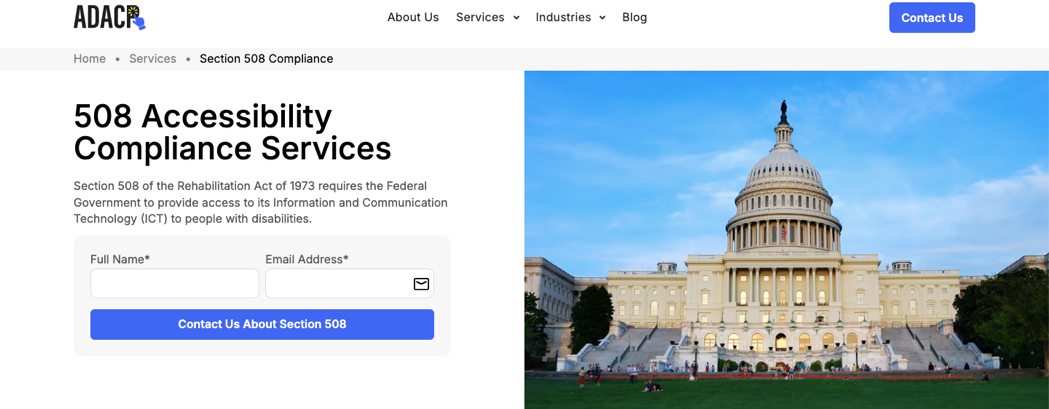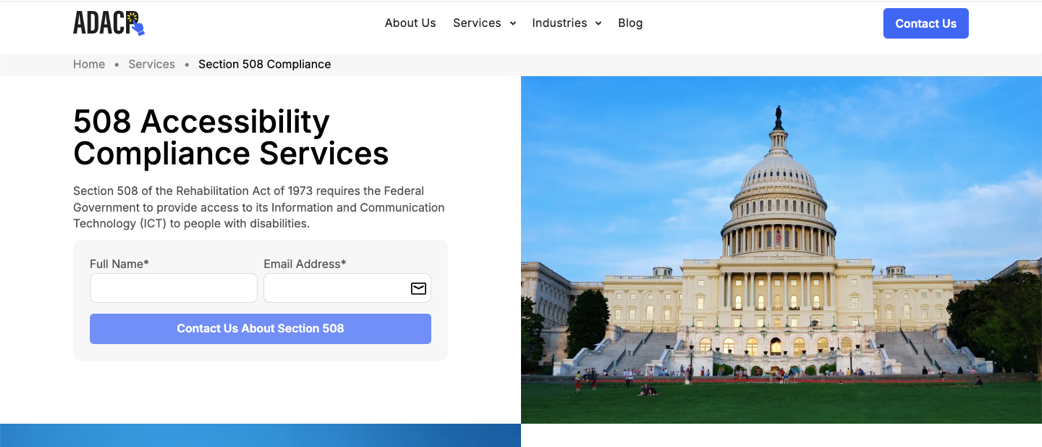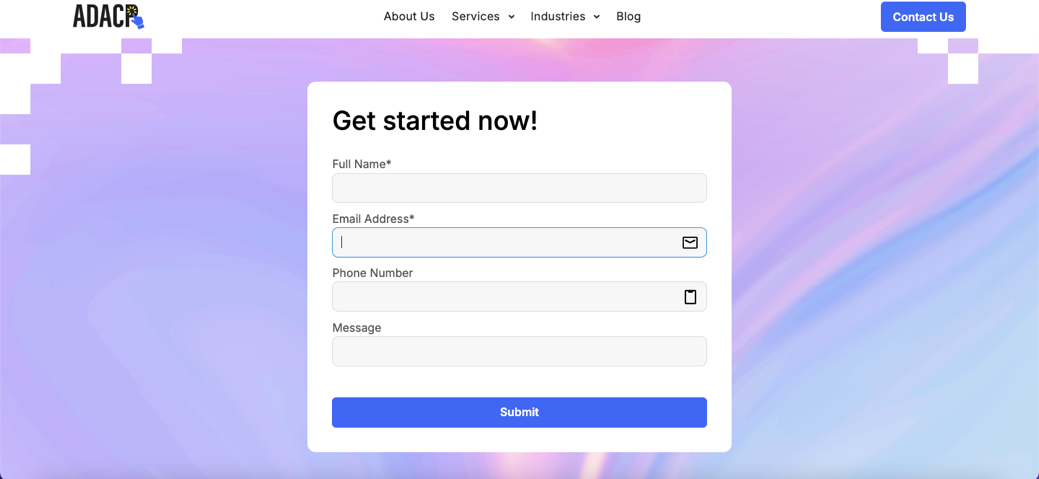
What Are the 508 Compliance Standards for Websites?

.webp)
Have you ever tried using a website that’s too hard to read or doesn’t work without a mouse? This happens all the time for people with disabilities.
That’s why Section 508 compliance standards exist for websites. According to this U.S. law, websites of businesses working with the government must be easy for everyone to use. There should be no accessibility barriers for users with visual, hearing or physical challenges.
So you have to make your website better and safer if it serves the public. Long story short, you need to know about 508 compliance.
TL;DR: Section508 is a US law that requires websites to be accessible for everyone. Your website must follow certain design and coding standards. The images on your website should have alt text and there should be keyboard navigation. Further, developers and designers should ensure that the website text is readable. These rules are based on WCAG Level AA guidelines. Many businesses use a VPAT or Voluntary Product Accessibility Template to prove accessibility compliance.
What is Section 508 and why is it crucial for business websites?
Section508 is part of the US Rehabilitation Act. This enforces rules for federal agencies to make their electronic and information technology accessible to all users.
Your website or software also needs to be 508 compliant if you are a contractor, vendor or organization doing business with a federal agency.
In short:
- If a website receives government funding, it must meet compliance norms.
- Even if you are not federally funded, 508 compliance testing is still useful. It will improve your SEO, content usefulness and legal safety.
What Does 508 Compliance Require for Websites?
Your website needs to follow WCAG 2.2 AA standards unless you cannot work with a federal agency. You can achieve digital accessibility through alt text for images and captions for videos. Simplify the keyboard navigation and choose colors that are easy on the eyes.
What Are the Key 508 Compliance Standards for Websites?
The U.S. Access Board updated Section 508 in 2018 to follow the international standard WCAG 2.2 Level AA. WCAG has three levels: A, AA and AAA. Level AA is the most practical and widely used for business websites. These are now the guidelines your website must meet.
Here is a simplified outline of the compliance guidelines:
Table 1: 508 Compliance Standards for Websites
Websites Must Include:
- Text alternatives for non-text content
- Keyboard navigation support
- Contrast ratio of at least 4.5:1
- Video captions and transcripts
- No flashing content (or warning if any)
- Forms with clear labels and instructions
How to tell if your website is 508 Compliant?
You will need 508 compliance testing by trained industry experts like ADACP. Then, you will get your 508 compliance certification in the form of a filled out VPAT. It is a document that evaluates how well your digital product meets 508 standards. For more details, refer to our blog on VPAT 2.5.
ADACP specializes in VPAT assessments using Section 508, WCAG 2.2, EN 301 549, and ADA Title III standards. Our team ensures:
- Accurate reporting not generic checklists
- Use of current standards (VPAT® Version 2.5, 2025)
- Clear documentation for government buyers
Is Section 508 the same as WCAG?
Section 508 is a US law and WCAG is a global standard. After the 2018 refresh, Section 508 follows the WCAG. When you aim for WCAG ,you digital content is also in line with 508.
What does Section 508 accessibility look like?
A simple example of how a small design change can make a website more accessible.
The screenshots below (Image 1 and Image2) show a button that changes color when the mouse hovers over it. This helps users understand what they are interacting with. But more importantly, the new hover color also meets the WCAG Level AA standard for color contrast.

Source: https://www.adacompliancepros.com/508-website-compliance

Source: https://www.adacompliancepros.com/508-website-compliance
This means:
- People with low vision or colorblindness can still see the button clearly.
- It works well in both light and dark modes.
- It passes automated contrast checkers used in accessibility audits.
Another important feature of an accessible website is that it works without a mouse. That means users can move through content using only their keyboard.
Our website’s Contact Us form is fully keyboard-navigable (Image 3). Press the Tab key, and you can jump from one field to the next:

Source: https://www.adacompliancepros.com/508-website-compliance
How Can I Make My Website 508 Compliant?
You will need to:
- Audit your current website manually and with tools
- Fix non-compliant issues like missing alt text and poor contrast
- Get a professional VPAT from experts like ADACP
508 Compliance Requirements Website Checklist
Table 2: 508 Compliance Requirements Checklist
Do All Websites Have to Be 508 Compliant?
Only federal agencies and vendors who sell to them are legally required to be 508 compliant. But private businesses benefit from following accessibility standards for SEO and legal safety.
Why Choose ADACP for 508 Compliance?
The right accessibility partner can protect your business from legal risks and help you win government contracts. We are the experts who handle VPAT assessments and 508compliance every day across industries and sectors.
ADACP is the smart choice for all your compliance related concerns:
We use the latest VPAT version 2.5:
Most companies still use outdated templates, but ADACP works with the most recent and accepted version of the VPAT 2.5. With us, your compliance reports will be the latest, complete and aligned with federal expectations.
We cover multiple global standards:
Section 508 is merely the beginning of accessibility evaluations. Our manual audits thoroughly align with WCAG 2.2, EN 301 549 (Europe) and ADA Title III (US law). We offer peace of mind to our clients working domestically and internationally.
We have real experts not just automation tools:
Automated scans often miss critical issues that affect real users. ADACP’s team includes human accessibility experts who test your product or website manually. The results are accurate and reflect actual usability for your target audience.
Our documentation is trusted by vendors and buyers:
We deliver clearly and professionally written VPAT reports. Federal buyers and procurement officers can easily understand your level of compliance. You increase your chance of winning bids and securing partnerships.
We respond fast and deliver real value:
You do not have to wait for weeks for a basic report. We provide quick turnaround, detailed feedback and ongoing support.
Schedule a free consultation on 508 compliance guidelines with ADACP today. Get your VPAT done fast, accurately, and by real experts.
Our highly experienced team ensures your product meets legal, ethical and technical standards without confusion or jargon.
Closing Thoughts
508 compliance standards help you create digital spaces that welcome everyone. And with ADACP by your side, complicated accessibility becomes doable.
So do not waste time anymore and boost your visibility right now with a Section 508 compliant website. Make a smarter and safer move by choosing ADACP for compliance audits and remediation.
FAQs
Q1: Is 508compliance required for mobile websites?
Accessibility applies across all platforms. If the mobile site is part of your main webservice then you have to consider 508 compliance requirements for it.
Q2: How often should I audit my website for 508 compliance?
You should per format least an annual audit. We even suggest expert led audit and remediation after major website updates. You should also stay up to date when laws and standards evolve.
Q3: Can automated tools guarantee compliance?
Tools can quickly catch some issues but only human review ensures real-world usability. You cannot rely on software scans for screen readers and cognitive disabilities.
Q4: What’s the penalty for not being 508 compliant?
Non-compliance can cost federal vendors valuable contracts. Ignoring accessibility in the private sector can open the door to ADA lawsuits or even hurt your brand.
Q5: What is the difference between 508 and ADA compliance?
Section 508 covers federal agencies and partners. The ADA (Americans with Disabilities Act)applies to the private sector and public spaces that serve the general public.
Have you ever tried using a website that’s too hard to read or doesn’t work without a mouse? This happens all the time for people with disabilities.
That’s why Section 508 compliance standards exist for websites. According to this U.S. law, websites of businesses working with the government must be easy for everyone to use. There should be no accessibility barriers for users with visual, hearing or physical challenges.
So you have to make your website better and safer if it serves the public. Long story short, you need to know about 508 compliance.
TL;DR: Section508 is a US law that requires websites to be accessible for everyone. Your website must follow certain design and coding standards. The images on your website should have alt text and there should be keyboard navigation. Further, developers and designers should ensure that the website text is readable. These rules are based on WCAG Level AA guidelines. Many businesses use a VPAT or Voluntary Product Accessibility Template to prove accessibility compliance.
What is Section 508 and why is it crucial for business websites?
Section508 is part of the US Rehabilitation Act. This enforces rules for federal agencies to make their electronic and information technology accessible to all users.
Your website or software also needs to be 508 compliant if you are a contractor, vendor or organization doing business with a federal agency.
In short:
- If a website receives government funding, it must meet compliance norms.
- Even if you are not federally funded, 508 compliance testing is still useful. It will improve your SEO, content usefulness and legal safety.
What Does 508 Compliance Require for Websites?
Your website needs to follow WCAG 2.2 AA standards unless you cannot work with a federal agency. You can achieve digital accessibility through alt text for images and captions for videos. Simplify the keyboard navigation and choose colors that are easy on the eyes.
What Are the Key 508 Compliance Standards for Websites?
The U.S. Access Board updated Section 508 in 2018 to follow the international standard WCAG 2.2 Level AA. WCAG has three levels: A, AA and AAA. Level AA is the most practical and widely used for business websites. These are now the guidelines your website must meet.
Here is a simplified outline of the compliance guidelines:
Table 1: 508 Compliance Standards for Websites
Websites Must Include:
- Text alternatives for non-text content
- Keyboard navigation support
- Contrast ratio of at least 4.5:1
- Video captions and transcripts
- No flashing content (or warning if any)
- Forms with clear labels and instructions
How to tell if your website is 508 Compliant?
You will need 508 compliance testing by trained industry experts like ADACP. Then, you will get your 508 compliance certification in the form of a filled out VPAT. It is a document that evaluates how well your digital product meets 508 standards. For more details, refer to our blog on VPAT 2.5.
ADACP specializes in VPAT assessments using Section 508, WCAG 2.2, EN 301 549, and ADA Title III standards. Our team ensures:
- Accurate reporting not generic checklists
- Use of current standards (VPAT® Version 2.5, 2025)
- Clear documentation for government buyers
Is Section 508 the same as WCAG?
Section 508 is a US law and WCAG is a global standard. After the 2018 refresh, Section 508 follows the WCAG. When you aim for WCAG ,you digital content is also in line with 508.
What does Section 508 accessibility look like?
A simple example of how a small design change can make a website more accessible.
The screenshots below (Image 1 and Image2) show a button that changes color when the mouse hovers over it. This helps users understand what they are interacting with. But more importantly, the new hover color also meets the WCAG Level AA standard for color contrast.

Source: https://www.adacompliancepros.com/508-website-compliance

Source: https://www.adacompliancepros.com/508-website-compliance
This means:
- People with low vision or colorblindness can still see the button clearly.
- It works well in both light and dark modes.
- It passes automated contrast checkers used in accessibility audits.
Another important feature of an accessible website is that it works without a mouse. That means users can move through content using only their keyboard.
Our website’s Contact Us form is fully keyboard-navigable (Image 3). Press the Tab key, and you can jump from one field to the next:

Source: https://www.adacompliancepros.com/508-website-compliance
How Can I Make My Website 508 Compliant?
You will need to:
- Audit your current website manually and with tools
- Fix non-compliant issues like missing alt text and poor contrast
- Get a professional VPAT from experts like ADACP
508 Compliance Requirements Website Checklist
Table 2: 508 Compliance Requirements Checklist
Do All Websites Have to Be 508 Compliant?
Only federal agencies and vendors who sell to them are legally required to be 508 compliant. But private businesses benefit from following accessibility standards for SEO and legal safety.
Why Choose ADACP for 508 Compliance?
The right accessibility partner can protect your business from legal risks and help you win government contracts. We are the experts who handle VPAT assessments and 508compliance every day across industries and sectors.
ADACP is the smart choice for all your compliance related concerns:
We use the latest VPAT version 2.5:
Most companies still use outdated templates, but ADACP works with the most recent and accepted version of the VPAT 2.5. With us, your compliance reports will be the latest, complete and aligned with federal expectations.
We cover multiple global standards:
Section 508 is merely the beginning of accessibility evaluations. Our manual audits thoroughly align with WCAG 2.2, EN 301 549 (Europe) and ADA Title III (US law). We offer peace of mind to our clients working domestically and internationally.
We have real experts not just automation tools:
Automated scans often miss critical issues that affect real users. ADACP’s team includes human accessibility experts who test your product or website manually. The results are accurate and reflect actual usability for your target audience.
Our documentation is trusted by vendors and buyers:
We deliver clearly and professionally written VPAT reports. Federal buyers and procurement officers can easily understand your level of compliance. You increase your chance of winning bids and securing partnerships.
We respond fast and deliver real value:
You do not have to wait for weeks for a basic report. We provide quick turnaround, detailed feedback and ongoing support.
Schedule a free consultation on 508 compliance guidelines with ADACP today. Get your VPAT done fast, accurately, and by real experts.
Our highly experienced team ensures your product meets legal, ethical and technical standards without confusion or jargon.
Closing Thoughts
508 compliance standards help you create digital spaces that welcome everyone. And with ADACP by your side, complicated accessibility becomes doable.
So do not waste time anymore and boost your visibility right now with a Section 508 compliant website. Make a smarter and safer move by choosing ADACP for compliance audits and remediation.
FAQs
Q1: Is 508compliance required for mobile websites?
Accessibility applies across all platforms. If the mobile site is part of your main webservice then you have to consider 508 compliance requirements for it.
Q2: How often should I audit my website for 508 compliance?
You should per format least an annual audit. We even suggest expert led audit and remediation after major website updates. You should also stay up to date when laws and standards evolve.
Q3: Can automated tools guarantee compliance?
Tools can quickly catch some issues but only human review ensures real-world usability. You cannot rely on software scans for screen readers and cognitive disabilities.
Q4: What’s the penalty for not being 508 compliant?
Non-compliance can cost federal vendors valuable contracts. Ignoring accessibility in the private sector can open the door to ADA lawsuits or even hurt your brand.
Q5: What is the difference between 508 and ADA compliance?
Section 508 covers federal agencies and partners. The ADA (Americans with Disabilities Act)applies to the private sector and public spaces that serve the general public.



.svg)
.svg)
.svg)

.webp)
























.svg)

.svg)